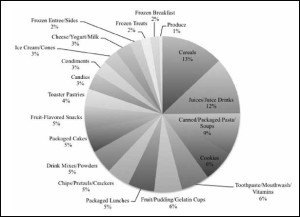Clinical Pediatrics, 2016 Oct; 55(12): 1113-1119.
In this study, 810 products commonly marketed to children and found in a local grocery store were evaluated. 43.2% of them contained artificial food colors (AFC), mostly Red 40, Blue 1, Yellow 5, and Yellow 6.
QUOTE: “Given concerns about health effects of AFCs and high proportions of high-AFC categories, clinicians, parents, food companies, and the government can take steps to support children’s healthy eating and development by reducing AFCs in children’s diets.”
NOTE: Michael Jacobson of the Center for Science in the Public Interest (CSPI) is a co-author of the study. See the CSPI Press Release here. Dr. Jacobson points out that of the various manufacturers, Kraft actually has dyes in 2/3 of their products sold for kids. No wonder they aren’t interested in answering requests by the Feingold Association to fill out forms even for products that appear to be all-natural.





















